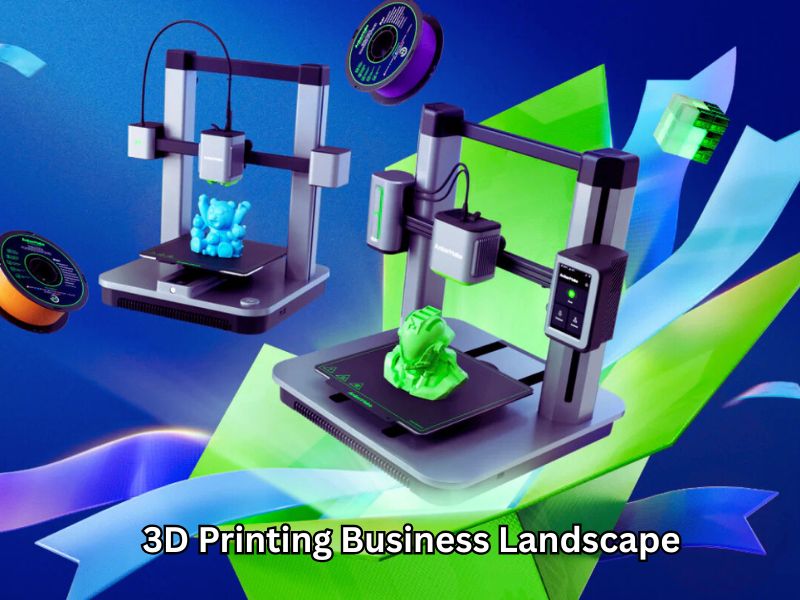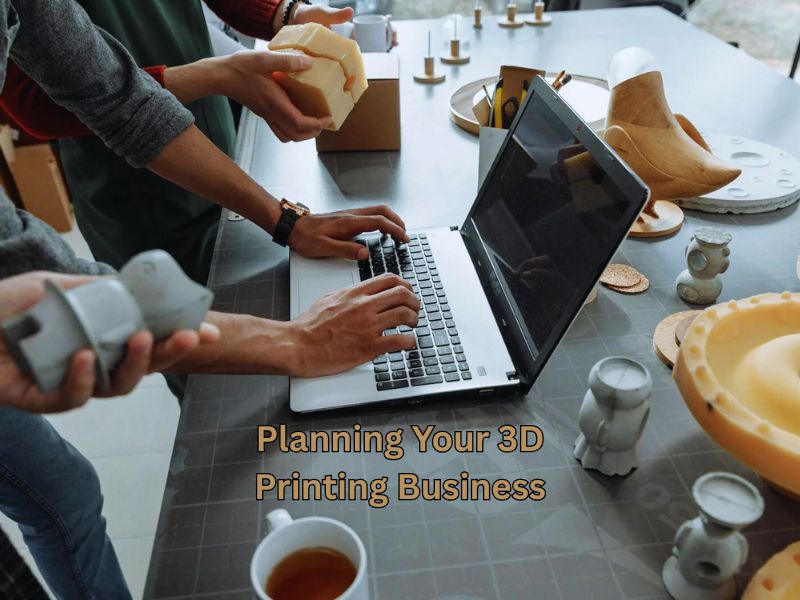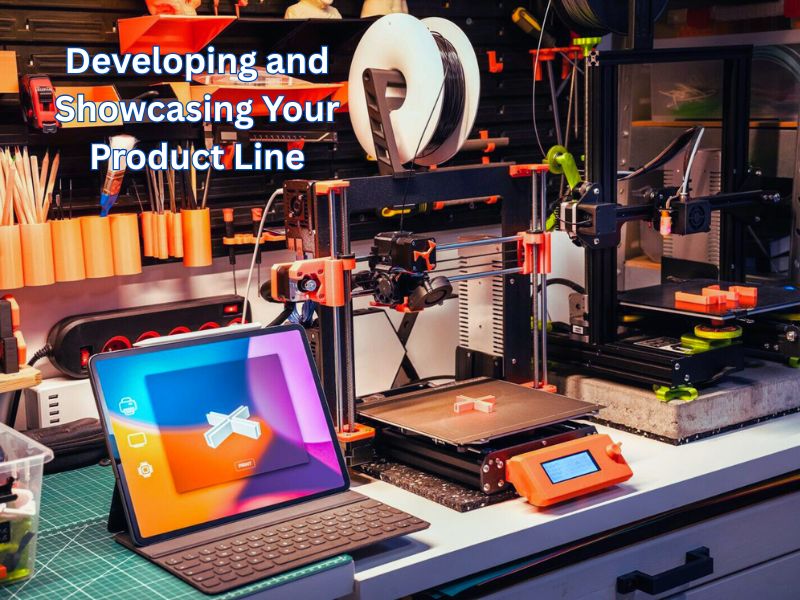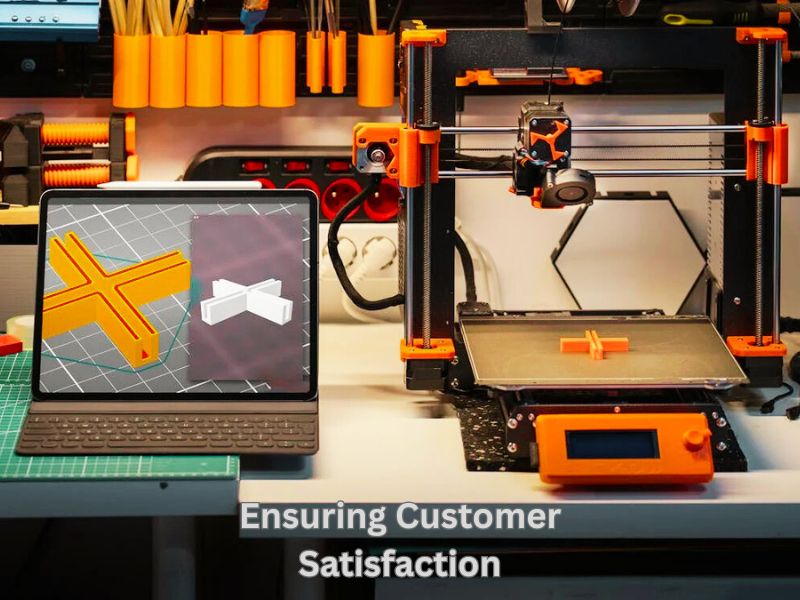Launching a 3D printing business in 2025 presents a promising opportunity to turn creativity into a profitable venture. With advancements in technology and increasing demand for customized products, entrepreneurs can tap into various markets, from personalized consumer goods to specialized industrial components. Learning how to start a 3D printing business the right way means understanding market needs, investing in the right equipment, and leveraging online platforms to build a strong brand that meets today’s evolving demands.
In this guide, we’ll explore the essential steps to launch your 3D printing business, including Market research, equipment selection, product development, and effective marketing strategies. Whether you’re a hobbyist looking to monetize your skills or an entrepreneur aiming to enter the manufacturing sector, this comprehensive resource will provide the insights needed to navigate the 3D printing industry successfully and help you find the best 3D printer for a small business to get started.
Let’s delve into the world of 3D printing and uncover the opportunities that await in this innovative field.

The 3D Printing Business Landscape
Understanding the 3D printing business landscape in 2025 reveals a dynamic and expanding market, offering diverse opportunities for entrepreneurs. Many of these niches require the ability to Create a 3D Model tailored to client needs. Key profitable areas include customized products, prototyping services, educational tools, and medical and dental applications.
Customized Products: Jewelry, Toys, and Home Decor
The demand for personalized items continues to grow, with consumers seeking unique jewelry, bespoke toys, and tailored home decor.
3D printing enables creators to design and produce these items efficiently, catering to individual preferences and trends.
Platforms like Etsy and Shopify have become popular marketplaces for selling such customized products, allowing businesses to reach a broad audience.
Prototyping Services for Startups and Inventors
Startups and inventors often require rapid prototyping to test and refine their products.
3D printing offers a cost-effective solution, enabling quick iterations and adjustments.
Many companies specialize in providing prototyping services, supporting innovation across various industries, including technology, healthcare, and automotive.
Educational Tools and STEM Kits
Educational institutions are increasingly incorporating 3D printing into their programs to enhance learning in science, technology, engineering, and mathematics (STEM).
Products like 3D printable kits offer hands-on learning experiences for students.
There is also a growing trend of open-source projects that provide free 3D printable construction sets, encouraging creativity and problem-solving skills.
Medical and Dental Applications
The medical and dental fields are seeing significant advancements through 3D printing technology.
In dentistry, 3D printing is used to create precise surgical guides, crowns, bridges, and dentures, improving patient outcomes and satisfaction.
The overall medical 3D printing Market is growing steadily, driven by the increasing demand for personalized treatments and shorter manufacturing times.
Analyzing Market Demand and Consumer Behavior
Understanding market demand and consumer behavior is crucial for starting a 3D printing business in 2025. Key audiences include hobbyists, businesses, and educators, all of whom seek affordable, customizable, and high-quality products. As competition intensifies in a $30 billion market, companies must innovate and deliver exceptional customer service to differentiate themselves and effectively meet the needs of consumers.

Laying the Foundation: Planning Your 3D Printing Business
Crafting a Solid Business Plan for Your 3D Printing Venture
Defining Your Business Model: Product Sales, Services, or Hybrid
When considering how to start a 3D Printing Business, it’s crucial to define your business model. You can focus on selling physical products, offer 3D printing services, or adopt a hybrid approach. For instance, you could design and sell custom jewelry while also offering prototyping services to local businesses. Understanding your business model is a key step in successfully starting a 3D Printing Business.
Setting Short-Term and Long-Term Goals
In the process of starting a 3D Printing Business, it’s essential to establish clear, measurable goals. Short-term objectives could include acquiring your first 10 clients or achieving a specific revenue target within six months. Long-term goals may involve expanding your product line or entering new markets in the next two years. Setting these goals is critical in How to Start a 3D Printing Business, as it ensures growth over time.
Budgeting and Financial Projections
As part of starting a 3D Printing Business, creating a comprehensive budget is vital. Account for all startup expenses, such as equipment, materials, software, and marketing. Developing financial projections enables you to estimate revenue, fees, and overall profitability, thereby managing your cash flow more effectively. Smart budgeting is a cornerstone in How to Start a 3D Printing Business and planning for future expansion.
Navigating Legal and Administrative Requirements
Choosing a Suitable Business Structure (LLC, Sole Proprietorship, etc.)
Select a business structure that aligns with your goals and offers the appropriate level of liability protection. A Limited Liability Company (LLC) is a popular choice for small businesses due to its flexibility and security of personal assets.
Registering Your Business and Obtaining Necessary Licenses
Register your business with the appropriate state authorities to obtain a legal operating status. Depending on your location and the nature of your business, you may need specific licenses or permits. Check with local government agencies to ensure compliance.
Understanding Tax Obligations and Compliance
Familiarize yourself with federal, state, and local tax requirements. This includes sales tax collection, income tax filings, and any industry-specific taxes. Consider consulting with a tax professional to ensure compliance and optimize your tax strategy.
Setting Up Your 3D Printing Workshop
Selecting the Right 3D Printer and Equipment
Choosing the right 3D printer is essential. For small businesses, FDM printers like the Creality Ender-3 V3 SE are affordable and user-friendly, while resin printers like the Phrozen Sonic Mighty 8K offer high precision. Essential accessories include print beds, filament storage, and cleaning tools to ensure efficient operation.
Workspace Setup Considerations
Your workspace should be well-ventilated, especially when using resin printers, and equipped with safety gear such as gloves and eyewear. Ensure there are enough power outlets and surge protection for your equipment.
Choosing the Appropriate Software and Materials
User-Friendly Design Software Options
Fusion 360 is an excellent choice for beginners and professionals, while Blender is ideal for artistic designs. FreeCAD is perfect for technical modeling.
Material Selection Based on Product Requirements
PLA is ideal for prototypes, ABS for durable parts, TPU for flexible items, and resins for high-detail prints. Choose materials based on your specific product needs.
Sourcing Reliable Suppliers for Filaments and Resins
Work with reputable suppliers to ensure consistent material quality and timely delivery. This ensures that your prints meet high standards for both durability and detail.

Developing and Showcasing Your Product Line
Designing Unique and Marketable 3D-Printed Products
Identifying Gaps in the Market for Innovative Products
To succeed, identify unmet needs through Market research. Identify areas where existing products fall short and develop solutions for niche markets, or refine existing designs to meet specific needs.
Incorporating Customer Feedback into Product Development
Engage with customers through surveys and reviews to gather insights for refining your products. This feedback ensures your products meet customer expectations and improve customer loyalty.
Ensuring Product Quality and Functionality
Use reliable materials and precise printing methods to ensure your products are durable and functional. Consistent quality assurance builds trust and reduces returns.
Building a Compelling Portfolio to Attract Clients
Creating High-Quality Images and Descriptions of Your Products
Showcase your products with high-resolution images and clear, concise descriptions. Highlight key features and present products from multiple angles to attract potential buyers.
Utilizing Online Platforms to Showcase Your Work
Establish a robust online presence by leveraging your website and e-commerce platforms. Leverage social media to boost visibility and drive traffic to your store.
Gathering Testimonials and Reviews to Build Credibility
Encourage customers to leave reviews. Positive feedback boosts your reputation and builds trust with potential customers.
Marketing Strategies to Grow Your 3D Printing Business
Establishing a Strong Online Presence
Developing a User-Friendly Website with E-Commerce Capabilities
Your website is the digital storefront for your 3D printing business. Make it easy to navigate, mobile-friendly, and visually appealing. Integrate e-commerce features to enable customers to browse, customize, and purchase products effortlessly.
Leveraging Social Media Platforms to Reach Your Audience
Social media helps you connect with potential customers. Use platforms like Instagram, Facebook, and TikTok to showcase your 3D products through engaging visuals and videos. Share behind-the-scenes content and customer testimonials to build trust.
Implementing SEO Best Practices to Increase Visibility
SEO boosts your visibility on search engines like Google. Utilize relevant keywords, optimize your site’s speed, and produce high-quality content to enhance search rankings and increase organic traffic to your site.
Engaging with the Community and Building Partnerships
Participating in Local Events and Maker Fairs
Attend local events, such as Maker Faires and trade shows, to showcase your products and connect with potential customers. These events help you gather feedback and expand your reach within the community.
Collaborating with Other Businesses and Influencers
Partner with local businesses or influencers who align with your brand. Collaborations introduce your products to new audiences and help build credibility in the Market.
Offering Workshops or Tutorials to Educate and Attract Customers
Hosting workshops or tutorials on 3D printing can position you as an expert. These sessions attract customers interested in learning about 3D printing and can help increase your brand’s visibility.

Managing Operations and Ensuring Customer Satisfaction
Managing operations and ensuring customer satisfaction are crucial for the success of any 3D printing business. Streamlining order processing, maintaining an organized inventory, and utilizing project management tools are essential for improving workflow efficiency. Implementing systems to track production schedules, manage digital inventory, and optimize resource allocation will help reduce lead times and minimize costs.
Clear communication channels are essential for delivering exceptional customer service. Responding to inquiries promptly and handling complaints with care builds trust. Additionally, offering loyalty programs with rewards and discounts can encourage repeat business, fostering long-term customer relationships.
Scaling Your 3D Printing Business for Long-Term Success
Exploring Opportunities for Expansion
Expanding your 3D printing business involves diversifying your product offerings and tapping into new markets. Consider the following strategies:
- Diversify Product Lines: Explore various applications of 3D printing, such as prototyping, customized products, footwear, collectibles, jewelry, art, product add-ons, 3D printing education, robotics, smartphone cases, home décor, medical models and training tools, architectural models, gaming accessories, and 3D printer rentals.
- Target New Markets: Identify underserved niches or emerging industries where 3D printing can provide unique solutions.
- Leverage Online Platforms: Utilize e-commerce platforms and digital marketing to reach a broader audience.
Staying Ahead with Continuous Learning and Innovation
To maintain a competitive edge, invest in continuous learning and innovation:
- Invest in Education: Enroll in online courses, attend workshops and seminars, and pursue certification programs to enhance your skills and knowledge in 3D printing.
- Foster a Culture of Innovation: Encourage creativity and experimentation within your team to develop new products and improve existing ones.
- Adopt Advanced Technologies: Stay updated with the latest advancements in 3D printing technologies and integrate them into your business operations to improve efficiency and product quality.
By strategically expanding your offerings and committing to continuous learning and innovation, you can position your 3D printing business for sustained growth and success in the evolving Market landscape.
Wrapping Up
Starting a 3D printing business in 2025 is more accessible than ever. With a clear niche, wise investment in equipment, and a focus on quality, many entrepreneurs are turning their passion into profit. For instance, some have started with minimal investment and now operate numerous printers, generating significant income. How to Start a 3D Printing Business begins with identifying your market and making informed decisions about the tools and services you’ll offer.
Whether you’re creating custom accessories, educational tools, or innovative prototypes, the key is to stay adaptable and continuously learn. Embrace new technologies, engage with your community, and always seek ways to innovate. Starting a 3D Printing Business involves constantly improving your process and staying ahead of the competition in this rapidly growing industry. With dedication and the right strategies, your 3D printing venture can thrive in this dynamic Market.
Frequently Asked Questions
What are the essential first steps to start a 3D printing business?
The process begins with thorough preparation and formalizing your operation:
Set Up a Dedicated Workspace: Ensure you have a proper workspace with ventilation for safety, as well as a stable temperature and humidity to maintain print quality.
Conduct Market Research: Research the current marketplace to identify your niche, understand customer needs, and spot gaps in demand. Use platforms like Etsy, Reddit, and Google Trends to see what’s selling.
Develop a Business Plan: Create a roadmap outlining your target Market, services offered, financial projections, pricing, and marketing plan. This is crucial for securing financing.
Choose Your Technology and Equipment: Ensure your 3D printing technology aligns with your niche. Options include FDM (Fused Deposition Modeling) for general-purpose use, SLA (Stereolithography) for high detail (like jewelry), or SLS (Selective Laser Sintering) for industrial parts. Purchase the best quality and most reliable printer you can afford.
Legally Establish Your Business: Organize your operation under a formal structure (e.g., LLC or sole proprietorship). Secure a legal business name, a local business license, and business insurance.
Is a 3D printing business profitable, and what are the best niches?
Yes, a 3D printing business can be profitable, but success hinges on finding a focused market niche and customers willing to pay for your unique products.
Profitable Niches and Business Ideas:
Spare Parts: Obsolete Manufacturing parts, no longer in production, or hard to find for appliances, antiques, or vehicles.
Prototyping: Creating functional prototypes and models for other companies, which is often faster and cheaper than traditional manufacturing.
Customized Products: Producing bespoke items like personalized phone cases, custom jewelry, specialized footwear, or even customized prosthetics and medical devices.
Collectibles and Gaming: Designing and selling unique miniatures, figurines, and gaming accessories (like dice holders or terrain pieces).
Home Decor & Art: Selling unique art pieces, modern vases, custom drawer knobs, and abstract sculptures.
What are the main challenges and disadvantages of running a 3D printing business?
While the industry offers design flexibility and rapid prototyping, there are several key challenges:
Scaling and Operations: Scaling from a single printer to a “print farm” requires implementing operational solutions (like cloud management software) to handle the large number of jobs efficiently, as manual operation becomes unsustainable.
High Initial and Ongoing Costs: The initial investment for professional-grade printers can be high, and there are ongoing costs for materials (filaments/resins), maintenance, utilities, and software.
Post-Processing: Many 3D printed parts require significant manual labor for post-processing (sanding, cleaning, removing supports) to achieve the desired finish and accuracy, which adds to the time and cost per part.
Limited Materials: Compared to traditional manufacturing, the selection of printable materials (plastics and metals) is still limited, and not all materials are easily recyclable or food-safe.
Intellectual Property (IP) and Copyright Issues: The accessibility of 3D printing makes it easier to create counterfeit or fake products, which can lead to copyright issues. You must create unique designs and respect IP laws.
How much does it cost to start a 3D printing business?
Startup costs vary widely based on the scale and quality of equipment you choose:
| Item | Estimated Cost Range | Key Consideration |
| 3D Printers | $200 – $5,000+ | Choose based on your budget, niche, and required print quality and reliability. |
| Materials | $20 – $200 per spool | Price varies based on the type (PLA, Resin, Nylon, etc.) and quality. |
| Computer & Software | $500 – $2,000 | Required for design (CAD) and slicing software. |
| Workspace | Varies | Costs range from a spare room at home to a rented space; must be well-ventilated. |
| Business Basics | $100 – $500 | Includes costs for registration, permits, and licenses. |
| Tools | $100 – $500 | Necessary for finishing and cleaning up prints. |

Comments are closed.